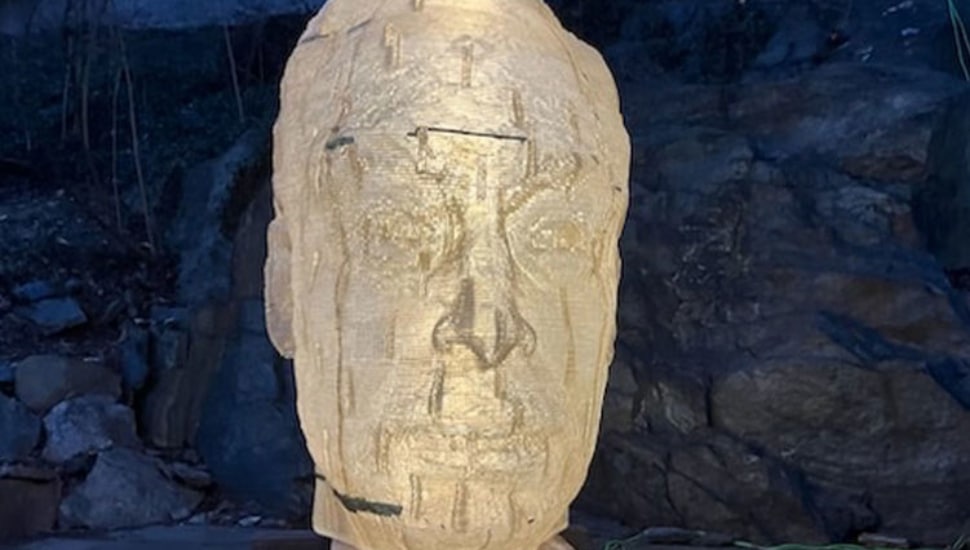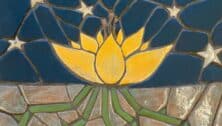‘Head’ to Penn State Abington To View Acclaimed Artist’s Outdoor Sculpture

When members of the campus community and area residents hit the walking paths at Penn State Abington over the next year, they will encounter something big in the outdoor amphitheater — Abu, an 8-foot tall acrylic sculpture that lights up from within after dark.
Yes, it’s a head, but it’s more than just a cranium. According to H. John Thompson, Director of the Abington Art Gallery and Associate Teaching Professor of Art who spearheaded bringing the piece to campus, it’s a mediation on love.
“At the core of the piece is a very humanistic experience that we’ll all share at some point, the witnessing of a loved one being sick and/or aging,” said Thompson. “This is where we can see the importance of the arts to inspire us to use technologies and processes to communicate important messages that are more often felt than described.”
Philadelphia Artist Miguel Horn created Abu to help process his emotions after his father was diagnosed with a serious illness several years ago. He specializes in developing large-scale public pieces using digital and analog processes, and his work often encompasses deterioration, memory, and impermanence.
“I’ve scaled his likeness to monumental proportions, capturing the great presence he holds in our family’s lives,” said Horn. “The surface is made up of layers of translucent acrylic sheet, stacked topographically to create his image. The fractured surface of this material reflects light from the surrounding environment and can muddle the overall image.”
In his role as gallery director, Thompson is charged with booking artists in part to serve as a living laboratory for students. However, the gallery is open to the campus community and beyond. He felt Horn’s work straddled art practices so Abington student artists would benefit from exploring the sculpture and an exhibit of his related work with faculty and on their own time.
“His work integrates very traditional sculpture techniques with current technology, which mirrors the potential for intersecting disciplines we have here at Penn State Abington,” Thompson said.
Abu’s journey to Abington was fraught. It was initially installed in the silty water at Penn’s Landing in Philadelphia for Flow, a 2019 exhibit of floating sculptural installations. Unfortunately, a freak storm tore through the region and broke it into pieces.
“Abu was built like a beast, but the tornado flipped it 180 degrees and ripped it off its moorings,” said Horn. “I was heartbroken.”
After dragging the pieces from the Delaware River to his West Philadelphia studio, Horn contemplated next steps while developing a series of related prints that are on view in the Abington Art Gallery.
Meanwhile, Thompson was so enamored with Abu when it was at Penn’s Landing that he convinced Horn to consider repairing it and moving it to campus.
“I thought Abington was pretty and serene and a really contemplative space and it would fit in well there,” said Horn, who reassembled Abu and used the Japanese practice of kintsugi gold leaf repair in specific areas.
Once repairs were completed, Horn loaded it onto a trailer for the 15-mile drive from West Philadelphia to Abington. They moved painstakingly up Broad Street, one of the city’s busiest and most congested routes, and met Thompson and Abington’s Business Operations grounds crew for another very slow drive along campus walkways to the amphitheater, where it was met by a forklift that moved it into its home for the next year.
“Exhibiting the sculpture at Abington gave Miguel an opportunity to show it in a different context,” said Thompson. “He labored to repair and reinforce the sculpture, and mending it was integral to its core content of what it means to be human and to experience a family member who is ill or aging.”
Learn more about Penn State Abington and how it provides an affordable, accessible, and high-impact education resulting in the success of a diverse student body.
Stay Connected, Stay Informed
Subscribe for great stories in your community!
"*" indicates required fields


![ForAll_Digital-Ad_Dan_1940x300[59]](https://montco.today/wp-content/uploads/sites/2/2022/06/ForAll_Digital-Ad_Dan_1940x30059.jpg)

































![95000-1023_ACJ_BannerAd[1]](https://montco.today/wp-content/uploads/sites/2/2023/03/95000-1023_ACJ_BannerAd1.jpg)






